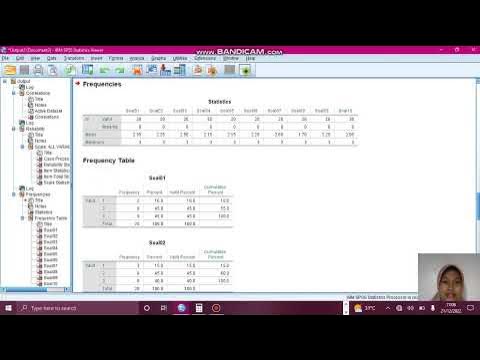Cara Menghitung Tingkat Kesukaran & Daya Pembeda Soal di Excel
Summary
TLDRIn this tutorial, the speaker demonstrates how to use Microsoft Excel to calculate the difficulty index and item discrimination power for multiple-choice questions (MCQs). The difficulty index assesses how easy or difficult a question is based on student responses, while the discrimination power evaluates how well a question distinguishes between high- and low-performing students. By following step-by-step instructions, viewers learn to use Excel functions to calculate and interpret these indices, improving the quality of their tests. The tutorial is ideal for educators looking to enhance their test analysis and design processes.
Takeaways
- 😀 The difficulty index helps to assess how easy or difficult a multiple-choice question is based on the number of correct answers from students.
- 😀 Difficulty index categories: 0.00-0.30 is 'Difficult', 0.31-0.70 is 'Moderate', and 0.71-1.00 is 'Easy'.
- 😀 The formula to calculate the difficulty index is: Total correct answers ÷ Total students.
- 😀 In Excel, the SUM function is used to calculate the total number of correct answers for each question.
- 😀 The discriminative power of a question evaluates how well it distinguishes between high and low-performing students.
- 😀 Discriminative power categories: 0.40 or higher is 'Very Good', 0.30-0.39 is 'Good', 0.20-0.29 is 'Adequate', and below 0.20 is 'Poor'.
- 😀 To calculate discriminative power in Excel, the formula is: (Average of High Group - Average of Low Group) ÷ Maximum score.
- 😀 Group students into two categories: top 50% (High Group) and bottom 50% (Low Group) to calculate discriminative power.
- 😀 The AVERAGE function in Excel is used to calculate the average score for both the High and Low Groups.
- 😀 Excel's sorting and filtering tools help organize student scores before categorizing them into the High and Low Groups for further analysis.
Q & A
What is the main focus of the video tutorial?
-The video tutorial focuses on calculating the difficulty index and discriminative power of multiple-choice questions (MCQs) using Microsoft Excel.
What are the categories for difficulty levels in MCQs, and how are they defined?
-The difficulty levels are categorized as: 0.00–0.30 (Difficult), 0.31–0.70 (Moderate), and 0.71–1.00 (Easy). These categories help to interpret the difficulty of each question.
What formula is used to calculate the difficulty index for each MCQ?
-The formula for the difficulty index is: total correct answers (or score) for each question divided by the number of students.
How do you calculate the difficulty index for each MCQ in Excel?
-In Excel, you use the SUM function to calculate the total correct answers for each question, then divide by the number of students. This value is categorized based on the predefined ranges.
What does the discriminative power of an MCQ indicate?
-The discriminative power indicates how well a question distinguishes between high and low-performing students, which is crucial for identifying the effectiveness of the question.
What are the categories for discriminative power and their meanings?
-The discriminative power categories are: 0.40 or higher (Very good), 0.30–0.39 (Good), 0.20–0.29 (Sufficient but needs improvement), and below 0.19 (Poor, needs to be discarded).
What is the formula for calculating the discriminative power of an MCQ?
-The formula for discriminative power is: (average score of the upper group - average score of the lower group) / maximum score.
How do you categorize students into the upper and lower groups for discriminative power calculation?
-Students are categorized into the upper and lower groups based on their scores. The top 50% are the upper group, and the bottom 50% are the lower group.
What steps are involved in calculating the discriminative power in Excel?
-To calculate discriminative power in Excel, first calculate the total score for each question. Then, categorize students into the upper and lower groups, calculate the average score for each group, and apply the discriminative power formula.
Why is it important to have a mix of easy, moderate, and difficult questions in a test?
-A mix of easy, moderate, and difficult questions ensures a well-balanced test that can differentiate between students with varying levels of ability, helping to assess the full range of student performance.
Outlines

هذا القسم متوفر فقط للمشتركين. يرجى الترقية للوصول إلى هذه الميزة.
قم بالترقية الآنMindmap

هذا القسم متوفر فقط للمشتركين. يرجى الترقية للوصول إلى هذه الميزة.
قم بالترقية الآنKeywords

هذا القسم متوفر فقط للمشتركين. يرجى الترقية للوصول إلى هذه الميزة.
قم بالترقية الآنHighlights

هذا القسم متوفر فقط للمشتركين. يرجى الترقية للوصول إلى هذه الميزة.
قم بالترقية الآنTranscripts

هذا القسم متوفر فقط للمشتركين. يرجى الترقية للوصول إلى هذه الميزة.
قم بالترقية الآنتصفح المزيد من مقاطع الفيديو ذات الصلة

Uji Butir Soal Pilihan Ganda dengan Excel

ANALISIS BUTIR SOAL (TINGKAT KESUKARAN)

Cara Menggunakan Fungsi MATCH, INDEX & CHOOSE dalam Ms Excel | Informatika Kelas 8 Bab Analisis Data

validitas, reliabilitas, tingkat kesukaran dan daya pembeda menggunakan aplikasi SPSS 26.

SPSS: How To Enter, Code, And Analyze Multiple Choice Data

UJI VALIDITAS, RELIABILITAS, TINGKAT KESUKARAN DAN DAYA PEMBEDA SOAL TIPE URAIAN
5.0 / 5 (0 votes)
